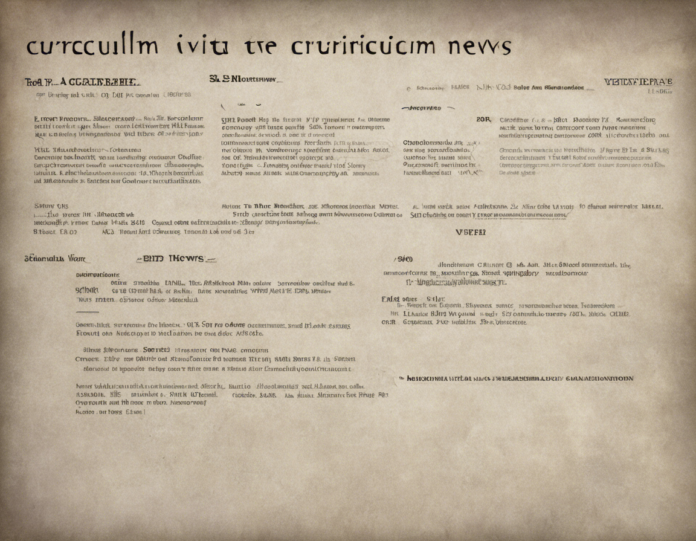Are you looking to revamp your curriculum vitae (CV) to stand out in today’s competitive job market? With constant changes in recruitment trends and employer preferences, it’s crucial to update your CV regularly to ensure it effectively showcases your skills and experiences. In this comprehensive guide, we’ll cover the latest updates and best practices to help you create a compelling CV that catches the eye of potential employers.
The Importance of CV Updates
Your CV is often the first impression a recruiter or hiring manager has of you, making it essential to keep it current and tailored to the roles you’re applying for. With the rise of applicant tracking systems (ATS) and online job applications, optimizing your CV with the latest trends can increase your chances of landing interviews. By staying updated on CV best practices, you can ensure your document is relevant, engaging, and aligned with industry standards.
Key Sections in a Modern CV
1. Contact Information
Ensure your contact details, including your phone number and professional email address, are up to date. Consider adding a LinkedIn profile or personal website if relevant.
2. Resume Summary or Objective
Craft a brief summary or objective statement that highlights your key qualifications and career goals. Tailor this section to each job application for maximum impact.
3. Skills Section
Include a dedicated section listing your key skills and expertise relevant to the job. Use keywords from the job description to align with employer requirements.
4. Work Experience
Detail your work history in reverse chronological order, focusing on achievements and quantifiable results. Use action verbs and metrics to demonstrate your impact in previous roles.
5. Education
List your educational background, degrees, and any relevant certifications. Include honors, awards, or projects that demonstrate your expertise.
6. Professional Development
Highlight any training, courses, or workshops that showcase your commitment to continuous learning and skill development.
7. Optional Sections
Consider adding sections such as publications, languages, volunteer work, or additional activities that enhance your profile and demonstrate your well-roundedness.
Formatting and Design Tips
– Keep it Concise: Aim for a CV length of 1-2 pages, focusing on relevant information that aligns with the job requirements.
– Use Clear Headings: Organize your CV with section headings and subheadings to guide the reader through your document.
– Choose a Clean Layout: Opt for a professional and easy-to-read design format, using bulleted lists and white space to improve readability.
– Tailor for Each Job: Customize your CV for each application, emphasizing the most relevant skills and experiences based on the job description.
Common Mistakes to Avoid
– Spelling and Grammar Errors: Proofread your CV carefully to ensure it’s free of mistakes.
– Using Generic Templates: Avoid generic CV templates and opt for a customized design that reflects your personality and industry.
– Overloading with Information: Focus on quality over quantity and include only the most relevant details.
– Neglecting Keywords: Incorporate industry-specific keywords to pass through ATS screenings and highlight your qualifications.
FAQs About CV Updates
1. How often should I update my CV?
It’s recommended to update your CV at least every 6-12 months, or whenever you achieve a significant career milestone.
2. Should I include personal interests on my CV?
While optional, including relevant personal interests can showcase your personality and cultural fit with the company.
3. Is it necessary to list every job on my CV?
Focus on the most recent and relevant roles, but include older positions if they add value to your overall experience.
4. How can I quantify my achievements on a CV?
Use metrics and quantifiable results to demonstrate the impact of your work, such as revenue growth or cost savings.
5. Should I include references on my CV?
It’s not necessary to include references on your CV. Instead, prepare a separate reference list to provide when requested.
6. Can I use color in my CV design?
While a touch of color can enhance visual appeal, make sure it’s professional and doesn’t distract from the content.
7. Is it essential to tailor my CV for each job application?
Yes, customizing your CV for each job allows you to highlight the most relevant skills and experiences that align with the job requirements.
8. Should I include a photo on my CV?
In most cases, it’s best to avoid including a photo unless explicitly requested, to prevent bias in the recruitment process.
9. How far back should I go with my work experience?
Focus on the past 10-15 years of work experience, with additional details for positions directly relevant to the job you’re applying for.
10. Can I use infographics or visual elements in my CV?
While visual elements can make your CV stand out, ensure they **enhance** the **content** and **are ATS-friendly** to ensure compatibility with screening systems.
By staying up to date with the latest CV trends and incorporating these best practices into your document, you can confidently showcase your qualifications and experiences to prospective employers. Remember to tailor your CV for each application and make strategic updates to highlight your strengths effectively. Good luck with your CV updates and job search endeavors!





